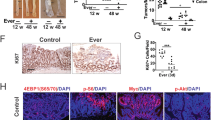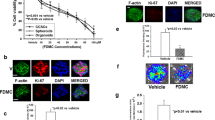Abstract
Cancer chemoprevention uses natural, synthetic, or biological substances to reverse, suppress, or prevent either the initial phase of carcinogenesis or the progression of neoplastic cells to cancer1. It holds promise for overcoming problems associated with the treatment of late-stage cancers. However, the broad application of chemoprevention is compromised at present by limited effectiveness and potential toxicity. To overcome these challenges, here we developed a new chemoprevention approach that specifically targets premalignant tumour cells for apoptosis. We show that a deficiency in the adenomatous polyposis coli (APC) gene and subsequent activation of β-catenin lead to the repression of cellular caspase-8 inhibitor c-FLIP (also known as CFLAR) expression through activation of c-Myc, and that all-trans-retinyl acetate (RAc) independently upregulates tumour necrosis factor-related apoptosis-inducing ligand (TRAIL) death receptors and suppresses decoy receptors. Thus, the combination of TRAIL and RAc induces apoptosis in APC-deficient premalignant cells without affecting normal cells in vitro. In addition, we show that short-term and non-continuous TRAIL and RAc treatment induce apoptosis specifically in intestinal polyps, strongly inhibit tumour growth, and prolong survival in multiple intestinal neoplasms C57BL/6J-ApcMin /J (ApcMin ) mice. With our approach, we further demonstrate that TRAIL and RAc induce significant cell death in human colon polyps, providing a potentially selective approach for colorectal cancer chemoprevention by targeting APC-deficient cells for apoptosis.
This is a preview of subscription content, access via your institution
Access options
Subscribe to this journal
Receive 51 print issues and online access
$199.00 per year
only $3.90 per issue
Buy this article
- Purchase on Springer Link
- Instant access to full article PDF
Prices may be subject to local taxes which are calculated during checkout




Similar content being viewed by others
References
Sporn, M. B., Dunlop, N. M., Newton, D. L. & Smith, J. M. Prevention of chemical carcinogenesis by vitamin A and its synthetic analogs (retinoids). Fed. Proc. 35, 1332–1338 (1976)
Pitti, R. M. et al. Induction of apoptosis by Apo-2 ligand, a new member of the tumor necrosis factor cytokine family. J. Biol. Chem. 271, 12687–12690 (1996)
Wiley, S. R. et al. Identification and characterization of a new member of the TNF family that induces apoptosis. Immunity 3, 673–682 (1995)
Koschny, R., Walczak, H. & Ganten, T. M. The promise of TRAIL-potential and risks of a novel anticancer therapy. J. Mol. Med. 85, 923–935 (2007)
Ashkenazi, A. Directing cancer cells to self-destruct with pro-apoptotic receptor agonists. Nature Rev. Drug Discov. 7, 1001–1012 (2008)
Moser, A. R., Pitot, H. C. & Dove, W. F. A dominant mutation that predisposes to multiple intestinal neoplasia in the mouse. Science 247, 322–324 (1990)
Su, L. K. et al. Multiple intestinal neoplasia caused by a mutation in the murine homolog of the APC gene. Science 256, 668–670 (1992)
Fodde, R. et al. A targeted chain-termination mutation in the mouse Apc gene results in multiple intestinal tumors. Proc. Natl Acad. Sci. USA 91, 8969–8973 (1994)
Altucci, L. et al. Retinoic acid-induced apoptosis in leukemia cells is mediated by paracrine action of tumor-selective death ligand TRAIL. Nature Med. 7, 680–686 (2001)
Sun, S. Y., Yue, P., Hong, W. K. & Lotan, R. Augmentation of tumor necrosis factor-related apoptosis-inducing ligand (TRAIL)-induced apoptosis by the synthetic retinoid 6-[3-(1-adamantyl)-4-hydroxyphenyl]-2-naphthalene carboxylic acid (CD437) through up-regulation of TRAIL receptors in human lung cancer cells. Cancer Res. 60, 7149–7155 (2000)
Jin, F. et al. Activation of nuclear factor-κB contributes to induction of death receptors and apoptosis by the synthetic retinoid CD437 in DU145 human prostate cancer cells. Cancer Res. 65, 6354–6363 (2005)
Yang, K. et al. A mouse model of human familial adenomatous polyposis. J. Exp. Zool. 277, 245–254 (1997)
Polakis, P. The many ways of Wnt in cancer. Curr. Opin. Genet. Dev. 17, 45–51 (2007)
Chen, D. et al. SKI activates Wnt/beta-catenin signaling in human melanoma. Cancer Res. 63, 6626–6634 (2003)
Ricci, M. S. et al. Direct repression of FLIP expression by c-myc is a major determinant of TRAIL sensitivity. Mol. Cell. Biol. 24, 8541–8555 (2004)
Nieminen, A. I., Partanen, J. I., Hau, A. & Klefstrom, J. c-Myc primed mitochondria determine cellular sensitivity to TRAIL-induced apoptosis. EMBO J. 26, 1055–1067 (2007)
Willson, J. K., Bittner, G. N., Oberley, T. D., Meisner, L. F. & Weese, J. L. Cell culture of human colon adenomas and carcinomas. Cancer Res. 47, 2704–2713 (1987)
Hasson, E. et al. Solid tissues can be manipulated ex vivo and used as vehicles for gene therapy. J. Gene Med. 7, 926–935 (2005)
Nusse, R. Wnt signaling and stem cell control. Cell Res. 18, 523–527 (2008)
Barker, N. et al. Identification of stem cells in small intestine and colon by marker gene Lgr5 . Nature 449, 1003–1007 (2007)
Bai, X., Sadat, S., Gehmert, S., Alt, E. & Song, Y. H. VEGF receptor Flk-1 plays an important role in c-kit expression in adipose tissue derived stem cells. FEBS Lett. 581, 4681–4684 (2007)
Ren, X., Xu, Z., Myers, J. N. & Wu, X. Bypass NFκB-mediated survival pathways by TRAIL and Smac. Cancer Biol. Ther. 6, 1031–1035 (2007)
Deng, Y., Ren, X., Yang, L., Lin, Y. & Wu, X. A JNK-dependent pathway is required for TNFα-induced apoptosis. Cell 115, 61–70 (2003)
Evans, G. S., Flint, N., Somers, A. S., Eyden, B. & Potten, C. S. The development of a method for the preparation of rat intestinal epithelial cell primary cultures. J. Cell Sci. 101, 219–231 (1992)
Wu, X. & Levine, A. J. p53 and E2F–1 cooperate to mediate apoptosis. Proc. Natl Acad. Sci. USA 91, 3602–3606 (1994)
Bai, X. et al. Electrophysiological properties of human adipose tissue-derived stem cells. Am. J. Physiol. Cell Physiol. 293, C1539–C1550 (2007)
Gimble, J. & Guilak, F. Adipose-derived adult stem cells: isolation, characterization, and differentiation potential. Cytotherapy 5, 362–369 (2003)
Acknowledgements
We thank H. Yang for technical support, R. Lotan for the BW1799 cells, and W. El-Deiry for DR5 expression plasmid; and M. Chambers, J. Yate, L. Ingram, D. Chow and G. Reyes for their involvement in IRB approval and human tissue acquisition. We also thank J. Vykoukal, A. E. Kadala and D. Malone for their help in editing the manuscript. This work was supported by NIH grant AI063063 and Institutional Funds from M. D. Anderson Cancer Center (to X.W.), and in part by Alliance of Cardiovascular Researchers grant 543102 (to E.A.).
Author Contributions X.W. designed and supervised the experiments, and also analysed the data and wrote the paper. X.R. initiated the experiments, and L.Z. performed most of the experiments and participated in designing experiments and analysing data. E.A. designed the mASC experiments and edited and partially wrote the paper. X.B. performed experiments in mASCs. S.H., Z.X. and X.-F.W. helped perform the experiments. P.M.L. provided human tumour samples. M.P.M. provided cell lines.
Author information
Authors and Affiliations
Corresponding author
Ethics declarations
Competing interests
The authors declare no competing financial interests.
Supplementary information
Supplementary Figures
This file contains Supplementary Figures 1-11 with legends. (PDF 5726 kb)
Rights and permissions
About this article
Cite this article
Zhang, L., Ren, X., Alt, E. et al. Chemoprevention of colorectal cancer by targeting APC-deficient cells for apoptosis. Nature 464, 1058–1061 (2010). https://doi.org/10.1038/nature08871
Received:
Accepted:
Published:
Issue Date:
DOI: https://doi.org/10.1038/nature08871
This article is cited by
-
Non-steroidal anti-inflammatory drugs induce immunogenic cell death in suppressing colorectal tumorigenesis
Oncogene (2021)
-
Recommendations for Specimen and Therapy Selection in Colorectal Cancer
Oncology and Therapy (2021)
-
Validation and application of a novel APC antibody in western blotting, immunoprecipitation, and immunohistochemistry
Medical Molecular Morphology (2018)
-
Adhesion and differentiation of Saos-2 osteoblast-like cells on chromium-doped diamond-like carbon coatings
Journal of Materials Science: Materials in Medicine (2017)
-
Apoptosis imaging by radionuclide probes
Journal of the Iranian Chemical Society (2017)
Comments
By submitting a comment you agree to abide by our Terms and Community Guidelines. If you find something abusive or that does not comply with our terms or guidelines please flag it as inappropriate.



